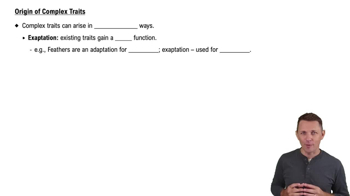Table of contents
- 1. Introduction to Biology2h 40m
- 2. Chemistry3h 40m
- 3. Water1h 26m
- 4. Biomolecules2h 23m
- 5. Cell Components2h 26m
- 6. The Membrane2h 31m
- 7. Energy and Metabolism2h 0m
- 8. Respiration2h 40m
- 9. Photosynthesis2h 49m
- 10. Cell Signaling59m
- 11. Cell Division2h 47m
- 12. Meiosis2h 0m
- 13. Mendelian Genetics4h 41m
- Introduction to Mendel's Experiments7m
- Genotype vs. Phenotype17m
- Punnett Squares13m
- Mendel's Experiments26m
- Mendel's Laws18m
- Monohybrid Crosses16m
- Test Crosses14m
- Dihybrid Crosses20m
- Punnett Square Probability26m
- Incomplete Dominance vs. Codominance20m
- Epistasis7m
- Non-Mendelian Genetics12m
- Pedigrees6m
- Autosomal Inheritance21m
- Sex-Linked Inheritance43m
- X-Inactivation9m
- 14. DNA Synthesis2h 27m
- 15. Gene Expression3h 20m
- 16. Regulation of Expression3h 31m
- Introduction to Regulation of Gene Expression13m
- Prokaryotic Gene Regulation via Operons27m
- The Lac Operon21m
- Glucose's Impact on Lac Operon25m
- The Trp Operon20m
- Review of the Lac Operon & Trp Operon11m
- Introduction to Eukaryotic Gene Regulation9m
- Eukaryotic Chromatin Modifications16m
- Eukaryotic Transcriptional Control22m
- Eukaryotic Post-Transcriptional Regulation28m
- Eukaryotic Post-Translational Regulation13m
- 17. Viruses37m
- 18. Biotechnology2h 58m
- 19. Genomics17m
- 20. Development1h 5m
- 21. Evolution3h 1m
- 22. Evolution of Populations3h 52m
- 23. Speciation1h 37m
- 24. History of Life on Earth2h 6m
- 25. Phylogeny2h 31m
- 26. Prokaryotes4h 59m
- 27. Protists1h 12m
- 28. Plants1h 22m
- 29. Fungi36m
- 30. Overview of Animals34m
- 31. Invertebrates1h 2m
- 32. Vertebrates50m
- 33. Plant Anatomy1h 3m
- 34. Vascular Plant Transport2m
- 35. Soil37m
- 36. Plant Reproduction47m
- 37. Plant Sensation and Response1h 9m
- 38. Animal Form and Function1h 19m
- 39. Digestive System10m
- 40. Circulatory System1h 57m
- 41. Immune System1h 12m
- 42. Osmoregulation and Excretion50m
- 43. Endocrine System4m
- 44. Animal Reproduction2m
- 45. Nervous System55m
- 46. Sensory Systems46m
- 47. Muscle Systems23m
- 48. Ecology3h 11m
- Introduction to Ecology20m
- Biogeography14m
- Earth's Climate Patterns50m
- Introduction to Terrestrial Biomes10m
- Terrestrial Biomes: Near Equator13m
- Terrestrial Biomes: Temperate Regions10m
- Terrestrial Biomes: Northern Regions15m
- Introduction to Aquatic Biomes27m
- Freshwater Aquatic Biomes14m
- Marine Aquatic Biomes13m
- 49. Animal Behavior28m
- 50. Population Ecology3h 41m
- Introduction to Population Ecology28m
- Population Sampling Methods23m
- Life History12m
- Population Demography17m
- Factors Limiting Population Growth14m
- Introduction to Population Growth Models22m
- Linear Population Growth6m
- Exponential Population Growth29m
- Logistic Population Growth32m
- r/K Selection10m
- The Human Population22m
- 51. Community Ecology2h 46m
- Introduction to Community Ecology2m
- Introduction to Community Interactions9m
- Community Interactions: Competition (-/-)38m
- Community Interactions: Exploitation (+/-)23m
- Community Interactions: Mutualism (+/+) & Commensalism (+/0)9m
- Community Structure35m
- Community Dynamics26m
- Geographic Impact on Communities21m
- 52. Ecosystems2h 36m
- 53. Conservation Biology24m
30. Overview of Animals
Overview of Animals
Problem 7
Textbook Question
Textbook QuestionEvaluate this statement: Animals evolved from simple to complex.
 Verified step by step guidance
Verified step by step guidance1
Step 1: Understand the statement. The statement is saying that animals evolved from simple forms to more complex forms. This is a common understanding of evolution, but it's important to note that 'simple' and 'complex' are relative terms.
Step 2: Consider the evidence. The fossil record shows that the earliest life forms were much simpler than most organisms alive today. Over time, new traits and structures have evolved, leading to a greater diversity and complexity of life.
Step 3: Consider the process of evolution. Evolution is driven by natural selection, where traits that improve an organism's chances of survival and reproduction are more likely to be passed on to the next generation. Over time, this can lead to the development of new traits and greater complexity.
Step 4: Consider exceptions. While it's generally true that life has become more complex over time, this is not a hard and fast rule. Some organisms have actually become simpler over time, losing traits that they no longer need. This is known as 'regressive evolution'.
Step 5: Formulate a response. Based on the evidence and understanding of evolution, it can be said that the statement is generally true, but with some exceptions. Evolution often leads to greater complexity, but not always.
Recommended similar problem, with video answer:
 Verified Solution
Verified SolutionThis video solution was recommended by our tutors as helpful for the problem above
Video duration:
1mPlay a video:
Was this helpful?
Key Concepts
Here are the essential concepts you must grasp in order to answer the question correctly.
Evolution
Evolution is the process through which species change over time through mechanisms such as natural selection, genetic drift, and mutation. It explains how simple organisms can give rise to more complex forms through gradual adaptations to their environments. Understanding evolution is crucial for evaluating claims about the progression from simple to complex life forms.
Recommended video:

Introduction to Evolution of Populations
Phylogeny
Phylogeny refers to the evolutionary history and relationships among species. It is often represented in a phylogenetic tree, which illustrates how different species are related through common ancestors. This concept helps in understanding the complexity of animal evolution and the branching patterns that lead to diverse forms of life.
Recommended video:
Guided course

Taxonomy and Phylogeny
Complexity in Biology
Complexity in biology often refers to the structural and functional intricacies of organisms. While some may interpret evolution as a linear progression from simple to complex, it is more accurate to view it as a branching process where complexity can arise in various forms, including multicellularity, specialization of cells, and behavioral adaptations. This understanding challenges the notion of a straightforward evolutionary ladder.
Recommended video:

Origin of Complex Traits

 5:58m
5:58mWatch next
Master Overview of Animals - 1 with a bite sized video explanation from Jason Amores Sumpter
Start learningRelated Videos
Related Practice











